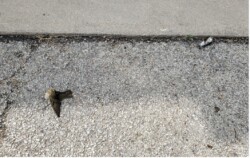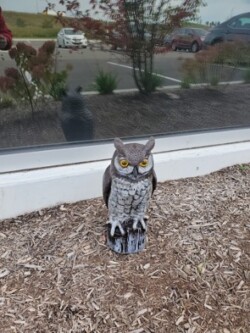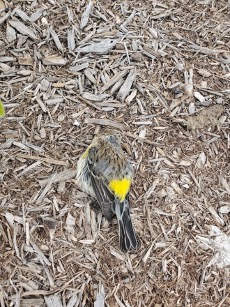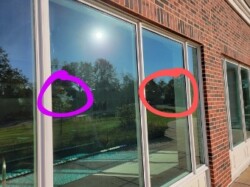Bird Window Collision Prevention Efforts Gone Wrong
May 26, 2022
ineffective.
When discussing how to save birds from the dangers of a forest of glass in our urban and residential environments, we typically provide tips on prevention tactics that work: moving bird feeders closer to windows, treating the glass with a product like Feather Friendly, and turning off lights, among other strategies.
This month, we’re going to talk about some of the things people do that DON’T work, and why people continue to try them. Here are three examples of collision prevention efforts gone wrong.
Bird Of Prey Decals
These decals were designed to prevent birds from slamming into windows. The thinking behind them is that the silhouette of a potential predator will prevent birds from going in the direction of that window. Unfortunately for the users of these decals, birds are smarter than that. They don’t see that decal and think it’s a real predator. It’s just a shape to fly around. As a result, birds often strike the glass adjacent to these decals.
How could you make this work? Put enough of these decals on the window to make any space between them smaller than 2” x 2”. Unfortunately, this would be unsightly, expensive, and make the window almost useless.

This is what we found below the windows.
Owl And Coyote Decoys
Not only do birds learn quickly that these aren’t real, but again, birds will just fly around them and strike nearby windows in the process, especially if the windows reflect bushes or trees that look like a good hiding place.
How to make this effort work? You can’t. Decoys are useless for preventing window collisions.

And just a couple feet away from this owl?

Ultraviolet Stickers
Just like bird of prey decals, these UV decals are not effective unless bunched together leaving no space larger than than 2” x 2” between them. That means you would have to cover nearly the entire window. Birds have evolved to be able to fly through tight spaces like leafy trees and bushes. One, or even a few, decals, won’t stop them from trying to get where they want to go. On top of that, not all birds can see UV light, and the transparent stickers won’t be visible to those birds at all. They also don’t work well unless the window is getting enough sunlight to trigger the UV effect, so they’re not effective at night when most birds migrate, or during early morning or evening hours, or if the window gets a lot of shade. To make matters worse, the UV on these products wears out in a few months, so they have to be replaced every migration season. This really isn’t practical at all, especially for a product that is only marginally effective to begin with.
How could you make UV decals work? Make sure you place only on windows that get regular direct sunlight. Use enough decals on the window to prevent spaces larger than 2” x 2”. Replace every 3-4 months.

This photo shows where a UV decal was placed (purple) and where a bird hit the window and left a mark (red).
Reliable Bird Collision Prevention Begins With Expertise
So if these products aren’t really effective, why do so many people try to use them?
They’re inexpensive, easy to use and often promoted with marketing that makes it seem as if they are more effective than they really are.
And there are a lot of people who search for these products, which frequently come up near the top of an online search if you simply google “birds hitting windows.”
The biggest problem however is misinformation. There’s a lot more marketing devoted to these products than reliable bird expertise.
Do your part by sharing reliable information on what works and what doesn’t and together we can begin to reduce the nearly 1 billion annual bird deaths in the U.S. that result from window and building collisions.
At Wild Goose Chase Indy, our biologist-led team is committed to safe, humane, and reliable solutions to bird conflicts wherever they occur. We have comprehensive and cost effective collision prevention solutions that begin with a full site, window and habitat assessment and include monitoring to determine the species and factors contributing to the problem.
If you are a property manager or owner who needs help with bird issues, give us a call to get started and we will assess your situation and identify the solution that is best for you.


 0
0
